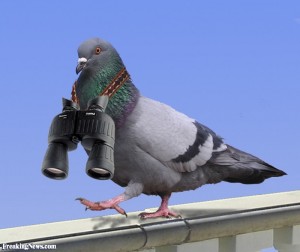It is no secret that birds have impeccable navigational skills. Flight permits long distance-travel, and tools such as differentiating smells in the air and using an internal compass make a smooth journey to the destination. For pigeons, it turns out that this journey is made smoother with use of visual memory towards stark edges in the landscape such as rivers, roads or large buildings. When using this visual method, pigeons can form a strict repetitive route home with an accuracy that rivals the GPS in your car. But, what happens when too many edges cause informational overload? Edge-dense cities are a new environment in the scheme of animal sensory adaptations, and promote sensory flexibility in this way. When it comes to chaotic urban environments, pigeons’ visual memorization method may be sadly compromised in favor of more appropriate navigational methods.
Pigeons generally change their flight behavior when approaching sharp edges in the landscape, and also avoid flying over vast edge-less forests. This points to the use of linear landmarks for homeward navigation, but evidence suggests that they may be unable to form memorized paths in highly urban environments. Since landscapes vary, a certain level of edge density is optimal for pigeons’ visual memories. Specifically, an abundance of these edges only benefits these memories to a certain point of chaos, but beyond this point, it only begins to hurt.
 To test pigeons’ visual navigation, areal images of separate landscapes were marked for their edge density level. Then, pigeons within these landscapes were fitted with a tracking micro GPS to monitor their flight path. They were then tracked from 4 different release sites. It turns out that pigeons stayed true to their route home in edge-dense areas that were still below a specific complexity. In the higher edge density landscapes, the overloaded pigeons neglected sticking to a memorized route.
To test pigeons’ visual navigation, areal images of separate landscapes were marked for their edge density level. Then, pigeons within these landscapes were fitted with a tracking micro GPS to monitor their flight path. They were then tracked from 4 different release sites. It turns out that pigeons stayed true to their route home in edge-dense areas that were still below a specific complexity. In the higher edge density landscapes, the overloaded pigeons neglected sticking to a memorized route.
We see pigeons in highly urban environments all of the time. So what does this mean for a home-seeking pigeon in the city? It will unlikely be able to form such a direct, strict route to the destination, and will instead exhibit more varied paths. Resorting to their sensitive ability to differentiate odors in the air combined with their innate solar compass is likely the answer in this case. So don’t worry about a lost and homeless pigeon in the city; sensory flexibility addresses the environmental problem.
Mann, R. P., Armstrong, C., Meade, J., Freeman, R., Biro, D., Guilford, T. (2014) Landscape complexity influences route-memory formation in navigating pigeons. Biology Letters, 10(1).


